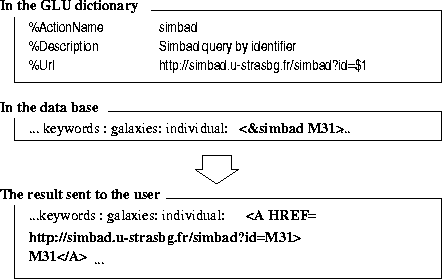 |
Next: The CDS Information Hub
Up: Astrostatistics and Databases
Previous: Information Mining in Astronomical Literature with Tetralogie
Table of Contents -- Index -- PS reprint -- PDF reprint
P. Fernique, F. Ochsenbein and M. Wenger
Centre de Données astronomiques de Strasbourg,
11 rue de l'université, 67000 STRASBOURG - FRANCE,
Email: question@simbad.u-strasbg.fr
In this context, the CDS (Centre de Données astronomiques de Strasbourg) has developed the GLU system (Générateur de Liens Uniformes). This tool allows all managers participating in the system to describe and easily distribute the URL definitions required to access their databases. The GLU system ensures that all GLU members receive these definitions and will receive all future modifications. So, the GLU system is particularly adapted to design cooperative Web services, allowing one to generate links to other services which remains always up-to-date.
The World Wide Web has allowed significant progress towards astronomical service interoperability : the Web is understood through all the Internet, it is very easy to interface it with databases, and hypertext is a powerful concept to obtain good interoperability between databases.
However for this last functionality, a keystone, the ability to define a unique access key to a given information location, the URN (Uniform Resource Name), is still missing. A IETF Working Group has been working on it for a few years, but there is presently no implementation of such a system (Berners-Lee 1994) Therefore everybody is still using URLs (Uniform Resource Locators) instead of URNs, with their well known drawbacks: at any time, any component of an URL (the hostname, the directory, the resource name and/or the parameter syntax) can be modified without any possibility of informing potential users.
The real challenge is thus to maintain all these URLs. For this, the Centre de Données astronomiques de Strasbourg (CDS ) has developed the GLU (Générateur de Liens Uniformes - Uniform Link Generator) which allows one to use symbolic names instead of hard-coded URLs in data.
To fulfill this aim, the GLU implements two concepts:
Using the GLU system, data managers can forget the URLs and just use their symbolic names - using GLU tags - in all their Web documents. Every time a server sends a database result, the GLU replaces, on the fly, the GLU tags by the corresponding URLs and substitutes the parameters at the proper locations (see the example in Figure 1).
The GLU system differs from other similar tools (such as the PURL system - developed by OCLC Office of Research) in that the GLU allows each of its members to locally resolve the URLs using its own view of the GLU dictionary. This is an important choice to ensure the resolution speed and the security of the system. So, for this replacement mechanism, only a simple modification to the Web server configuration is required: specifying that the data streams have to be filtered by the GLU resolver during output. For the advanced Web programmer, the GLU has two libraries, one in Perl, the other in C to resolve GLU tags directly in CGI (Common Gateway Interface) programs.
An important piece of the GLU system is the mechanism maintaining each view of GLU dictionary. This task is performed by a daemon, called glud, which has the responsibility to send and to receive the GLU records (the entries in the dictionary).
The GLU protocol used by these daemons has the following characteristics:
Several other functionalities are also addressed by the GLU system, the most important being:
To take the full benefit of all GLU facilities, three GLU tools have been developed:
Presently, two centers use the GLU system : the CDS, for its own Web services, and the CNES, the French Space Agency for the Space Physics database project (CDPP).
The GLU package has been designed for a large cooperation and is opened to other astronomy partners.
Egret, D., et al., 1998, this volume
Wenger, M, 1996 et al., Bull. American Astron. Soc., 189, 602
Berners-Lee, T., 1994, Request For Comments 1630
Next: The CDS Information Hub
Up: Astrostatistics and Databases
Previous: Information Mining in Astronomical Literature with Tetralogie
Table of Contents -- Index -- PS reprint -- PDF reprint